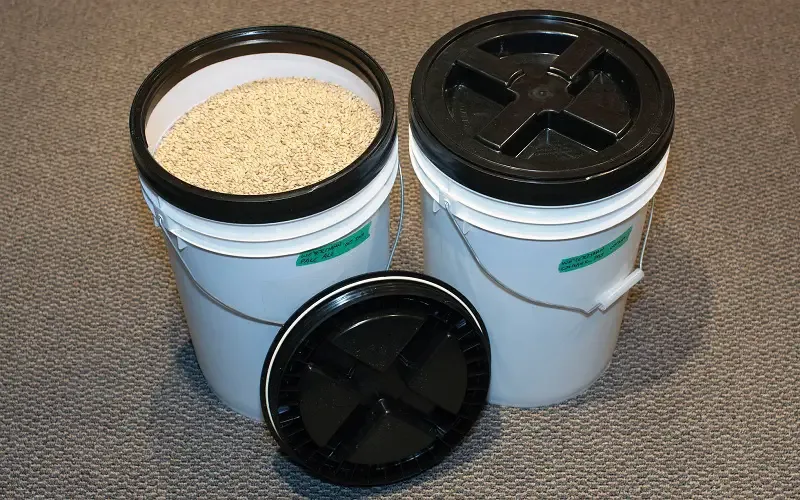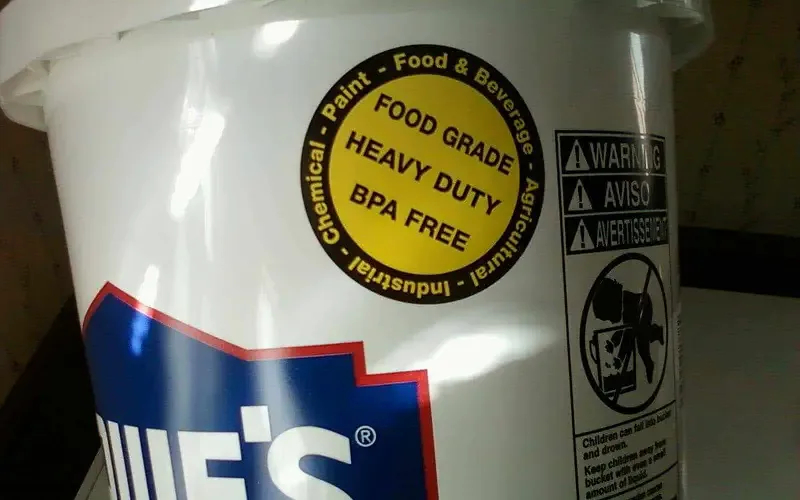SHTFDad may collect a share of sales or other compensation from the links on this page.
Are you tired of traditional food storage methods that don’t cut it? Then get ready for a revolution in how you store your favorite treats!
Welcome to the world of storing food in buckets. It’s an innovative and incredibly effective approach to keeping food fresh and flavorful.
Imagine having a storage solution that not only protects your food from spoilage but also saves space and money. With this method, you can say goodbye to cluttered pantries.
You’ll say hello to a streamlined and organized kitchen. So, how does it work? It’s remarkably simple yet incredibly effective.
High-quality, airtight buckets serve as the ultimate guardians of your food items. These containers create a protective barrier. It protects your food from air, moisture, pests, and temperature fluctuations.
You can store almost anything. Food in buckets will stay safe and sound. Get ready to enter a new era of food storage. You’ll get durability, convenience, and, above all, taste!
Why Store Food in Plastic Buckets?
When people think about how to store food in buckets, the first thing they think about is why they should do it. The thing is that this is a new way of storing food.
After all, previously, people did not use it practically or very little. This method has gained popularity among individuals, families, and people engaged in survival.
These versatile containers have proven to be reliable allies. They will help you in your quest to store food effectively for the long term. We have prepared some answers for you.
They will help you understand why you need to store things in buckets. You’ll understand why this method is a strategy that will change your life:
- Durability and Stackability: buckets made from high-quality food-grade plastic are extremely durable. It gives you peace of mind that you can use them for a long time. They have sturdy construction. It allows them to withstand a variety of storage conditions. It makes them ideal for both indoor pantries and outdoor emergency stockpiles. In addition, they have a uniform shape. This shape allows you to stack them easily, maximizing space efficiency.
- Versatility: This type of pail applies to storing food only in dry form. You may well store liquids there as well. It can be water, vegetable oil, or even homemade sauces. The versatility of plastic hips allows you to use them to store a wide range of food products. It offers a complete storage solution.
- Transparency: Many plastic buckets are transparent or translucent. It allows you to identify the contents of food stored in buckets without opening them. This feature simplifies the process of finding specific items. It makes it easier to organize and manage your stockpile.
- Protection from pests and contaminants: Let’s be honest: plastic buckets have a tight-fitting lid. It is what serves as an effective barrier against pests. You don’t have to worry about insects or rodents attacking your products. This type also protects the food from possible contamination. It ensures that your food is safe to eat.
Food in buckets is a practical and efficient way to store safe, organized food.
This option is suitable for those preparing for unstable times and ordinary people. If you want to optimize your kitchen stockpiles, this is your option.
Tips for Storing Food In Buckets
Storing food long-term in buckets can be a smart way to keep your edibles fresh and organized.
To get the most out of this food storage method, consider the following tips:
- Use food buckets: Make sure you choose food-grade plastic buckets that are safe for food storage.
- Cleanliness: Before you put food in buckets, you must ensure they are clean. The easiest way to do this is by washing them.
- Airtight lids: Take care of quality lids that provide an airtight seal and keep air and moisture out.
- Oxygen absorbers: Use oxygen absorbers to extend shelf life by removing residual oxygen.
- Labeling and date: Clearly label each bucket with the contents and date of storage.
- Organize and group: Store similar products together for efficient organization and inventory management.
- Store in the right conditions: Find a cool, dry, dark place to prevent spoilage and maintain food quality.
- Don’t overfill: Leave room for the contents to expand with temperature changes.
If you’re wondering how to store food in buckets, follow our tips. These efficient and effective food preservation methods will help you.
And in an emergency or for everyday use, they will be fit for consumption.
Advantages Of Storing Food in Buckets
Many people think of storing food for quite a long time. So, storing food in buckets has several advantages.
They make it the preferred method of food preservation for many people:
- Airtight protection: Plastic pails are equipped with secure snap-on lids. They create an airtight seal. This barrier prevents acid and moisture from penetrating. These are the main culprits behind food spoilage. Thanks to the airtight protection, the food stays fresh. You will experience nutritious sensations for a long time.
- Cost-effective: Plastic buckets are a budget-friendly option for food storage. They tend to be more affordable than other containers. For example, glass jars or metal cans cost twice or three times as much as plastic. But still, they will be about the same in terms of efficiency. Bulk purchasing and storing food in buckets can save money. It is especially important when preparing for emergencies or stocking up on essentials.
- Space efficiency: Typically, these buckets are uniform in shape. It will allow you to stack them easily. It will maximize the space in your pantry, closet, or pantry. This organized approach to storage allows you to use space more efficiently. It is especially effective when it comes to large stockpiles of food.
- Durability: Food-grade plastic buckets are often designed to resist wear and tear, ensuring longevity. They are less prone to breakage compared to glass containers. Plus, they are often lighter in weight, making them easier to transport.
- Easy to carry: Many plastic buckets for long-term food storage have sturdy handles. It allows you to carry them easily, even if they are full of food. This convenience is especially valuable in emergencies. Or you may appreciate it when moving supplies to different locations.
Thus, the benefits of storing food in buckets are cost-effectiveness, long-term storage, versatility, space-saving, and durability.
Are you preparing for emergencies or want to streamline your food organization? Then food storage in buckets will be a practical and efficient solution. We are confident that you will not regret this choice.
How to Store Food Long-Term in Buckets
Storing long-term food in buckets requires careful preparation and attention. This way, you can ensure the best possible preservation.
Below, we have provided a step-by-step guide. It will help you store food in buckets for a long time.
- Choose food-grade buckets: Choose high-quality buckets made of food-grade plastic. This kind is specifically designed for storing food.
- Clean and sanitize the buckets: Wash the buckets thoroughly with hot, soapy water to remove dirt, dust, and food residue. Rinse them well to make sure there is no soap residue. Sanitize the buckets, rinse them again, and allow them to air dry completely.
- Choose oxygen absorbers: For optimal preservation, you should use oxygen absorbers. They will help remove any residual oxygen inside the buckets. Place the appropriate amount of oxygen absorbers in each bucket.
- Fill the buckets: Carefully fill clean and dry buckets with food. It is best to store similar foods together. It will make it easier for you to organize and find them.
- Seal the buckets airtight: Securely place the lids on the buckets, creating an airtight seal. Double-check that no air can enter or escape the buckets.
- Label and date: Clearly label each bucket with its contents and the date of storage. It helps you keep track of what you have. And ensures proper rotation of stock based on expiration dates.
- Store it in a cool, dry place: Find a cool, dry, and dark storage location for the buckets. Avoid areas with temperature fluctuations or direct sunlight.
- Periodic inspection: Inspect food in buckets regularly for signs of spoilage or broken seals. Replace damaged or spoiled buckets and rotate stock.
Follow our recommendations. That way, you can confidently store food in buckets for a long time. You will be able to ensure their freshness, safety, and flavor for longer.
Final Thoughts
So if you had a question about how to store food in buckets, hopefully, after our text, you got the answers. Storing food in buckets is a practical and effective way to store food for a long time.
Using buckets made of food-grade plastic and proper storage methods will extend the shelf life of various foods. This way, you can save space and money.
The tightness and versatility of the buckets protect them from spoilage and contamination. Don’t forget to inspect and change your supplies periodically to maintain freshness.
Whether preparing for emergencies or looking to get rid of pantry clutter, this method will keep your food supplies stocked while providing convenience and organization. Happy bucket storage!
References:




